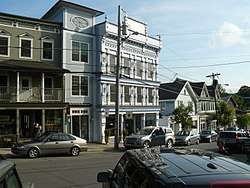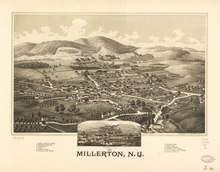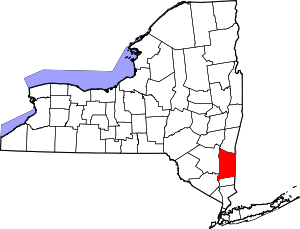Millerton, New York
Millerton is a village in Dutchess County, New York, United States with a population of 958 at the 2010 census.[2] The village was named after Sidney Miller, a rail contractor who help to bring the railroad to that area.
Millerton, New York | |
|---|---|
 Business district in Millerton | |
 Location of Millerton, New York | |
| Coordinates: 41°57′14″N 73°30′28″W | |
| Country | United States |
| State | New York |
| County | Dutchess |
| Town | North East |
| Area | |
| • Total | 0.62 sq mi (1.61 km2) |
| • Land | 0.62 sq mi (1.60 km2) |
| • Water | 0.004 sq mi (0.01 km2) |
| Elevation | 709 ft (216 m) |
| Population (2010) | |
| • Total | 958 |
| • Estimate (2018)[1] | 922 |
| • Density | 1,500/sq mi (600/km2) |
| Time zone | UTC-5 (Eastern (EST)) |
| • Summer (DST) | UTC-4 (EDT) |
| ZIP code | 12546 |
| Area code(s) | 518 |
| FIPS code | 36-47361 |
| GNIS feature ID | 0957337 |
| Website | www |
Millerton is part of the Poughkeepsie-Newburgh-Middletown Metropolitan Statistical Area of New York as well as the larger New York-Newark-Bridgeport NY-NJ-CT-PA Combined Statistical Area.
Millerton was named one of "The Ten Coolest Small Towns in America" by Frommer's Budget Travel Magazine in 2007,[3] and has been featured in the New York Times article "Williamsburg on the Hudson".[4]
Millerton is within the town of North East and is near the border of Connecticut. The town borders Taconic State Park.
History
The community of Millerton formed after 1851, and the village was incorporated in 1875.
Irondale

The Millerton Iron Company established itself nearby in an area known as Irondale and was served by a telegraph address in Millerton. The foundry had two Cooper hot blast stoves and produced car-wheel pig iron (cast iron for railcar wheels) with a 12,000 ton capacity in 1890.[5] The plant was established in 1854 and by 1882 employed approximately 150 people. Irondale was served by a general store, company owned grist mill, and post office.[6] A historical marker commemorates the Irondales Cemetery (List of New York State Historic Markers in Dutchess County, New York).
Economic cycle and development
Millerton's life cycle is explained in the New York Times article "Williamsburg on the Hudson" from the perspective of a lifelong-citizen, Phil Terni, who has lived in Millerton for more than 65 years. Terni describes Millerton's early prosperity as "an agricultural crossroads with three hotels served by three railroads", and then described the village's decline as the milk processing plant shut down and the farms had started shutting down.
Millerton's revival as "a rural village with urban influences from nearby towns and boroughs" is shown through the vibrant arts, culture and new small businesses along U.S. Route 44.
Geography
Millerton is located in northeastern Dutchess County. According to the United States Census Bureau, the village has a total area of 0.62 square miles (1.6 km2), of which 0.00 square miles (0.01 km2), or 0.50%, is water.[2]
The closest rail station is now Wassaic station to the south. The town formerly had its own station on the Harlem Line.
Demographics
| Historical population | |||
|---|---|---|---|
| Census | Pop. | %± | |
| 1880 | 600 | — | |
| 1890 | 638 | 6.3% | |
| 1900 | 802 | 25.7% | |
| 1910 | 858 | 7.0% | |
| 1920 | 829 | −3.4% | |
| 1930 | 910 | 9.8% | |
| 1940 | 953 | 4.7% | |
| 1950 | 1,048 | 10.0% | |
| 1960 | 1,027 | −2.0% | |
| 1970 | 1,042 | 1.5% | |
| 1980 | 1,013 | −2.8% | |
| 1990 | 884 | −12.7% | |
| 2000 | 925 | 4.6% | |
| 2010 | 958 | 3.6% | |
| Est. 2018 | 922 | [1] | −3.8% |
| U.S. Decennial Census[7] | |||
As of the census[8] of 2000, there were 925 people, 375 households, and 232 families residing in the village. The population density was 1,470.4 people per square mile (566.9/km²). There were 412 housing units at an average density of 654.9 per square mile (252.5/km²). The racial makeup of the village was 93.51% White, 2.27% African American, 0.32% Native American, 1.30% Asian, 0.11% Pacific Islander, 1.41% from other races, and 1.08% from two or more races. Hispanic or Latino of any race were 3.89% of the population.
There were 375 households out of which 29.3% had children under the age of 18 living with them, 45.3% were married couples living together, 12.5% had a female householder with no husband present, and 38.1% were non-families. 32.0% of all households were made up of individuals and 14.4% had someone living alone who was 65 years of age or older. The average household size was 2.44 and the average family size was 3.09.
In the village, the population was spread out with 24.4% under the age of 18, 8.3% from 18 to 24, 27.8% from 25 to 44, 24.0% from 45 to 64, and 15.5% who were 65 years of age or older. The median age was 40 years. For every 100 females, there were 88.8 males. For every 100 females age 18 and over, there were 89.9 males.
The median income for a household in the village was $36,176, and the median income for a family was $46,458. Males had a median income of $27,279 versus $29,500 for females. The per capita income for the village was $17,220. About 7.7% of families and 14.3% of the population were below the poverty line, including 24.7% of those under age 18 and 12.0% of those age 65 or over.
Arts and culture
The village hosts several foodie destinations, such as Manna Dew (wine bar and restaurant), the Oakhurst Diner, 52 Main Street, the Millerton Inn and a farmers market, all featuring the produce of dozens of local farms and vineyards. There is a recording studio and music school, "the music cellar", right on the bike path, or "rail trail". The Movie House features foreign films, live broadcasts of the Metropolitan Opera, and a cafe/gallery dubbed as one of the "best hipster hangouts" by Hudson Valley Magazine readers. Millerton has a number of art galleries, artist studios, and hosts the annual "Spring for Art" festival each May.
The community is served by weekly newspaper The Millerton News.
Notable people
- Eddie Collins, Hall of Fame baseball player for the Chicago White Sox and the Philadelphia Athletics [9]
- Daryl Hall, singer-songwriter and location of Daryl's House[10][11][12]
References
- "Population and Housing Unit Estimates". Retrieved February 22, 2020.
- "Geographic Identifiers: 2010 Demographic Profile Data (G001): Millerton village, New York". U.S. Census Bureau, American Factfinder. Archived from the original on February 13, 2020. Retrieved November 16, 2015.
- "Archived copy". Archived from the original on 2009-01-07. Retrieved 2009-01-26.CS1 maint: archived copy as title (link)
- Applebome, Peter. "Hudson River Valley Draws Brooklynites".
- "Directory of Iron and Steel Works of the United States and Canada". American Iron and Steel Institute. 17 September 1890 – via Google Books.
- Smith, James Hadden; Cale, Hume H.; Roscoe, William E. (17 September 1882). "History of Duchess County, New York: With ... Biographical Sketches of Some of Its Prominent Men and Pioneers". D. Mason & Company – via Google Books.
- "Census of Population and Housing". Census.gov. Retrieved June 4, 2015.
- "U.S. Census website". United States Census Bureau. Retrieved 2008-01-31.
- "Eddie Collins Stats". Baseball-Reference.com. Retrieved 2020-05-04.
- Youngs, Ian (13 August 2008). "Talking Shop: Daryl Hall". BBC. Retrieved 21 August 2017.
- "Daryl Hall: Interview Live from Daryl's House". Blues & Soul. Retrieved 21 August 2017.
- Graf, Gary (20 September 2011). "Exclusive: Daryl Hall's Web Show Coming to Broadcast TV". Billboard. Retrieved 21 August 2017.
External links
| Wikimedia Commons has media related to Millerton, New York. |
